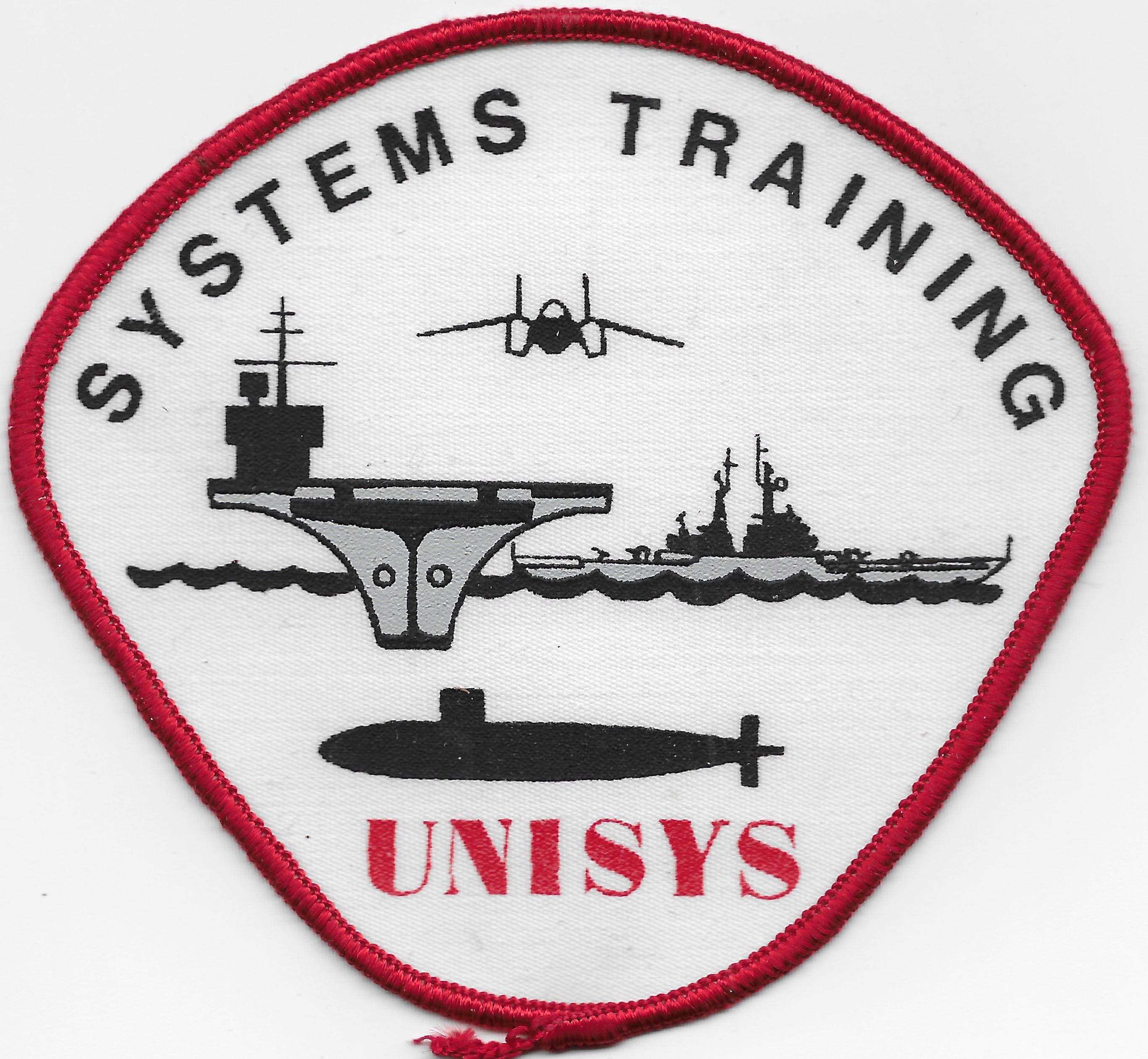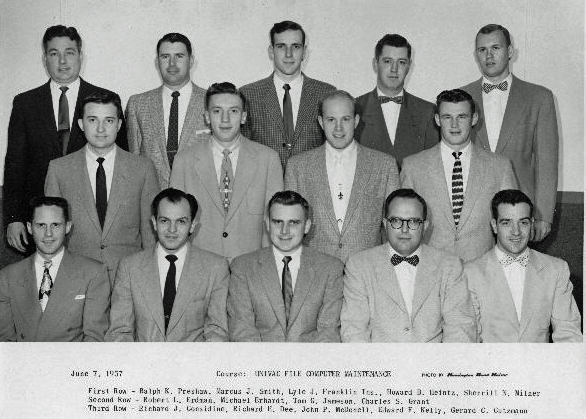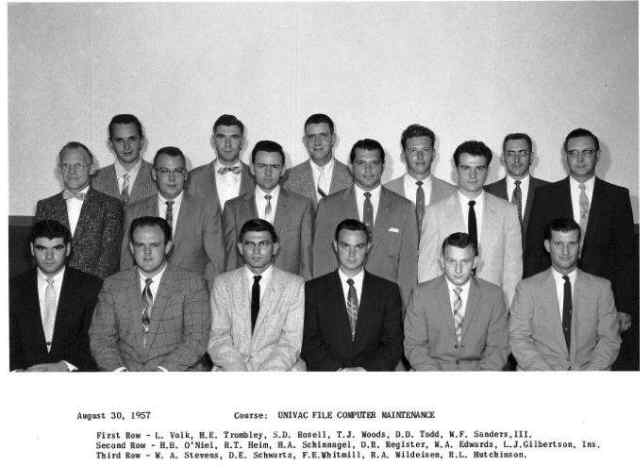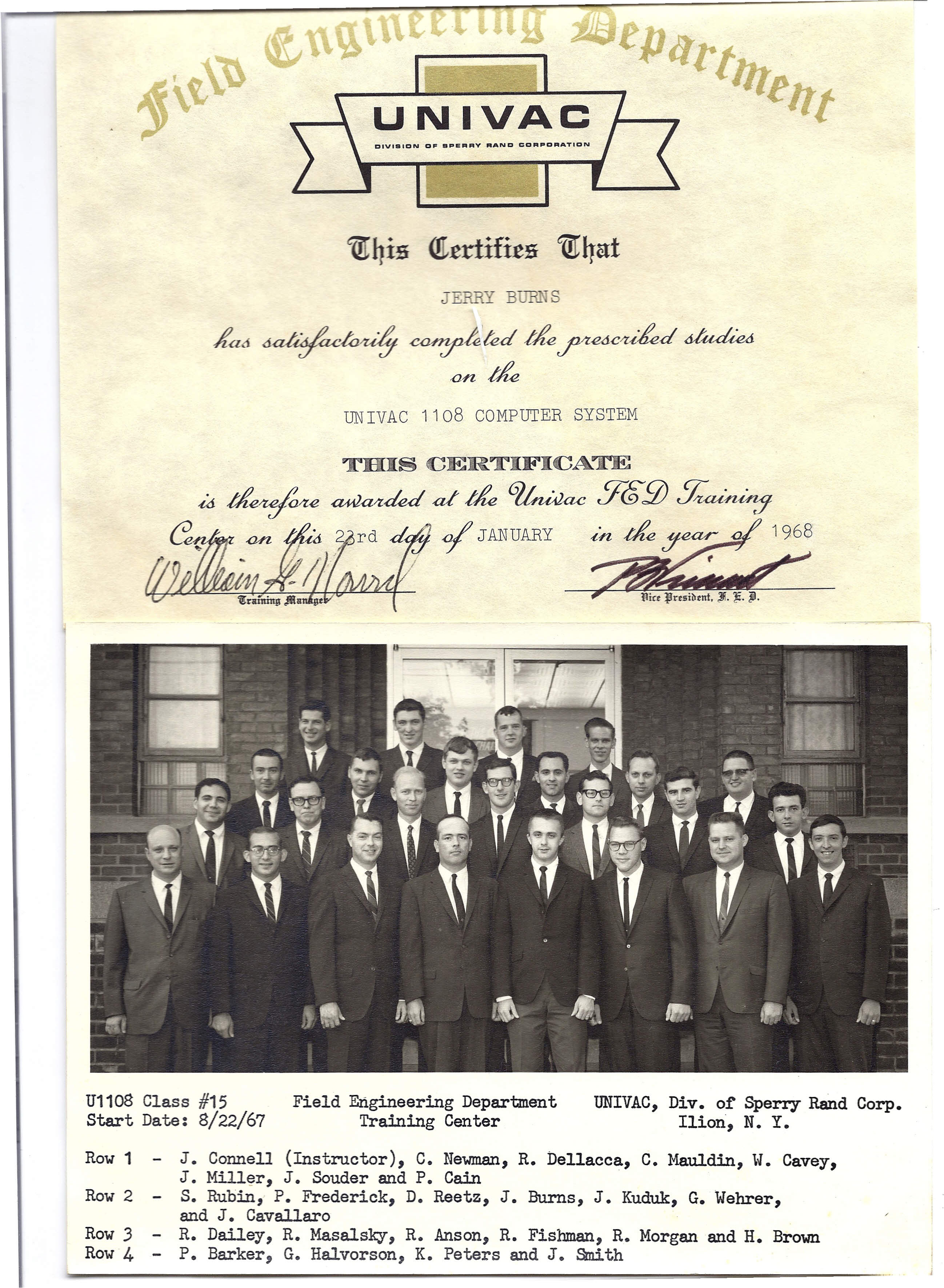

Information Technology (IT) Pioneers
Retirees and former employees of Unisys, Lockheed Martin, and their heritage companies
Training-Engineering, Chapter 49
1. Introduction
 Many of our early computer staff got their beginning in the Training
Departments - first as a student, then in field service or as an instructor
followed by an engineering or marketing job followed by various management
positions.
Many of our early computer staff got their beginning in the Training
Departments - first as a student, then in field service or as an instructor
followed by an engineering or marketing job followed by various management
positions.
A few of the career summaries mention the first plant 6, alongside the Mississippi River across the street from the old Ford plant.
Thanks to Lyle Franklin for most of this chapter's text and for getting the Legacy Project started on this aspect of our Information Technology Legacy. [lab]
2. Training Department
2.1 Lyle Franklin's Recollections
My introduction to the Mod O training Dept. was shortly after being hired into the Ed LaFluer group as a field engineer. Ed was in charge of the Mod O field engineers. I was then scheduled for the training program. Dick Roessler was the instructor. In the class were two former instructors whom I knew from Keesler AFB named Charley Jordan and Larry Savage. At the time I had heard that orders had been received for 168 production units. There was an urgent need for field engineers as well as test stand personnel. Later it was announced that Charley was to lead the Mod O training group and Larry was to be an instructor. The class was taught from the logic diagrams as there were no books. Dick Roessler used the serial 3 prints as a teaching aid. Unfortunately, the class was given serial 10 prints which altered some of the answers to the test questions. Students Ken Pommier, Marcus Clark and I questioned some of the test answers.
Upon completion of the class, the three of us were selected to be instructors. As I had just returned from overseas and my last assignment was as a radar maintenance NCOIC at a 5x7 island off the coast of Okinawa, a tour in St. Paul was most appealing. Later we were joined by Lyle Gilbertson, Ed Siokowski, Dick Wagner, and John Saline. Dick Huberty was a guest lecturer on the HP model 35 oscilloscope.
The peripheral equipment was a separate group. The only persons I can remember were Jake Oswald and Al Gresbrink. Ernie Haight was also a guest lecturer on programming. As I was about to leave the group others were hired and they were designated to transfer to Utica. I taught three classes of field engineers and Quality Control (QC). At the time Bob Groeshen was the head of Quality Control for the Mod O, the production and test was in the old plant 3. The training department and field engineering were in plant 6 which at that time was at East River Road and Ford Parkway just North across the street from the Ford Plant. During my student and early teaching days we were in the basement and shared the building with NWA stewardess training. It did interrupt the routine when the girls would sun themselves on the grids which covered our ceiling windows. Later we had the entire building which then housed Field Engineering. In the building was the Physics Laboratory with Dr. Sid Ruebens and Dr. Pom. As one of the Mod O processor registers was transistorized, I was designated to find out how transistors worked from the Dr. Pom. After a meaty session learning PNP and NPN and that holes moved slower than electrons - I adopted the on/off approach for explaining the circuits.
As an aside we had a big billboard outside with the meathead logo
which read, "Enter the world of tomorrow, today." Some disgruntled employee
added "At yesterday's wages."
![]()
2.2 Tactical Air Command (TAC) System Training
When I joined the group it was in its infancy. Ed Olzewski led the group and the cadre was the Technician Training crew consisting of Don Colbert, Joe Benton, Marv Nickell, and Glen Kregness. As I was very familiar with logic diagrams I was able to decipher the Voice and Digital Converters. Next we attacked the digital display. The others worked on the front-end units with some assistance. Al Gresbrink from the Peripheral Training Group joined us. Al had been a Navy Chief and was very knowledgeable of analog computers. Later Lyle Gilbertson, Ron Abecht and Ed Siolkowski, John Saline and Dick Huberty joined us. As I remember the course was ten weeks, which later was followed by a six-week, specialist course taught at Shaw AFB in Columbia, SC. The ten-week course was taught in segments with Glen and I teaching the Voice and Digital Converters. Thank God for Al Gresbrink, as he really knew how the gears moved for the Vector Computer. He had been a Navy Chief and was an analog expert. Glen and I also taught the Officers System Course with Al’s help.
In between classes we filled other jobs. John Saline and I were assigned to engineering to work on the TACS card tester design with Don Grittner. The unit was designed for interconnects from card to tester via plug ins. We designed the tests as well as the wiring diagrams for the plug ins. There were 244 card types both analog and digital, vacuum tube and transistor. Lyle Gilbertson and Dick Huberty were assigned to work on the large-scale display manufactured by Skiotron. Others were assigned to help Bill White’s group finishing the pubs.
Upon completion of the card tester I was assigned to write and conduct first article testing of the Voice and Digital Converters. The training group also installed the system at Shaw AFB in Columbia, SC. Later as I was no longer in Training I was drafted to teach the six weeks Vector Computer Group Specialist Course at Shaw. Thank God for SGT. Jones. He was the expert not me.
Clint Haggerty would be a good source for the Field Engineering effort, which was led by Roy Hegler. As I remember the training dept. only taught two individuals, Bill Poole and Don Woodard.
2.3 Mod 0 Training Class by Lyle Franklin

This photo on the right is from June 7, 1957 - Instructor was Lyle Franklin.
Front row left to right: Ralph K. Preshaw, Markus J. Smith, Lyle J. Franklin Ins.,Howard B. Heintz, Sherrill N. Milner
Second row: Robert L. Erdman, Michael Erhardt, Tom G. Jameson, Charles S. Grant
Third row: Richard J. Considine, Richard H. Dee, John P. McDonell, Edward F. Kelly, Gerald C. Gutzman
No longer have the pictures of the first two classes I taught. Lyle
2.4 Technician Training
In plant 6 we had other training prior to becoming Defense Systems Division. There was the Technician Training led by Ed Olszewski consisting of Don Colbert, Marve Nickle, Joe Benton, Glen Kregness, and guest speaker, Dick Huberty. They taught the technician skills of circuitry, use of tools, soldering printed circuit boards, and the good old Model 35.
Also there was the Athena Training Group under George Cogar. The only person I can think of in that group was Gary Holthusen. Then we had the NTDS training Group led by Clint Haggerty and later "Fig" I can probably handle the TACS training. Don't know who could provide data on NIKE.
I mentioned peripheral training but as stated Jake Oswald in San
Diego is the only name I can think of who still is with us.[lf]
![]()
2.5 UNIVAC File Computer Maintenance
 Photo on the right from Lyle Gilbertson, instructor.
Photo on the right from Lyle Gilbertson, instructor.
first row are: L. Volk, H. Trombley, S. Rosell, T. Woods, D. Todd, and W. Sanders
second row: are H O'Niel, R Helm, H. Schlanagel, D. Negister, W. Edwards, and Lyle Gilbertson
third row are: W. Stevens, D Schwartz, F Whitall, R Wildeisen, and H. Hutchinson.
2.6 UNIVAC Scientific - 1103A
Photo and comments below are from Tom Bayless; first row, second
from the right.
George Bryan, Jr. was a Lt. Cdr. and our onsite liaison on the Sea Surveillance
Program.
Ron Tingquist was a Univac employee, but I don't remember what group
he was associated with.
P. Willmer and E. Carter were Brits and I think part of commercial endeavor.
Gunther Paprotny was our instructor and heavy German accent. Good instructor
though.
Bob Engels was a Univac employee. He was an excellent programmer and
was around quite a while if I remember rightly.
We always knew J. Bjustrom as Jim. He was around for some number of
years, but was always just Cherie's husband. {Jim and
Cheri Bjustrom lived just down the block from Lowell Benson's
Ingerson Road home in Shoreview.}
Dave
Lewis had been a Mathematics Prof. at Mankato State, but I don't
remember him being around very long. Seems to me that Don Moe knew him
from his college days.
Joan Tanzer was on our Sea Surveillance team. She was a recent Math
grad from St. Catherines in St. Paul Minnesota. She later became a good friend of Betty's
{nee Laun, Tom Bayless' first wife} through their St. Kates relationship.
She left to start a family after just a few years.
I don't remember anything about K. Peng or R. Watson.
{Editor's Note: R.C. 'Bob' Hanson, second row - first
from the right, has a
career summary
on this web site. He also was the VIP Club President in 2013
and Vice President in 2012. }
![]()
2.7 UNIVAC 1108
This training certificate scan of Jerry Burns completing the UNIVAC 1108 COMPUTER SYSTEM Field Engineering training
came from Frank Ciesla via Paul Dickson.
Mr. Burns is in the center of the 2nd row.

3. People Stories
Quite a few people began their ERA/UNIVAC/UNISYS careers in the training department. I've included a couple of contributed tidbits. [lab]
3.1 Glen Kregness by Lyle Franklin
As an aside, Glen Kregness was hired by Ed Olzewski for technician
training. When Ed was given responsibility for AN/USQ-13 TACS training,
he brought his whole staff which consisted of Joe Benton and Marv Nichols
as well as Glen into the group. I was recruited as I had been in training
and also was NCOIC of a radar maintenance group, the same radar that
the Q-13 was using. We learned the system by going through the logic
diagrams. Glen was assigned as my assistant instructor for the Officers'
System course. As the TACS computer was analog, in our spare time I
taught Glen the Mod 0 File Computer. After TACS Glen was assigned as
lead instructor for the Q-17. When Vern Leas made the decision to redesign
the NTDS computer, Glen was transferred into engineering.
![]()
3.2 Gary Holthusen by Lyle Franklin
Many years ago in the mid 50s, there was no DSD - just Remington Rand Univac, St. Paul. There wasn't even a Roseville facility. In a previous e-mail, I mentioned Gary Holthusen. Gary started as an instructor on the Athena program. Years later Gary was the DSD marketing representative in Germany. That was in the late 60's early 70's. When he came back to St. Paul he reported to me. What brings this to mind is one day Gary asked me, "What is DS-4772?" I told him he should know as his signature was on the approval list. {Editor's note: See Engineering, Interfaces.}
3.3 Your Story Here?
In this Chapter
- Introduction [left]
- Training Department
- Lyle's Recollections
- Tactical Air Command
- Mod 0 Training Class
- Technician Training
- File Computer
- UNIVAC Scientific, 1103A
- UNIVAC 1108
- People Stories
Chapter 49 edited 7/13/2025.